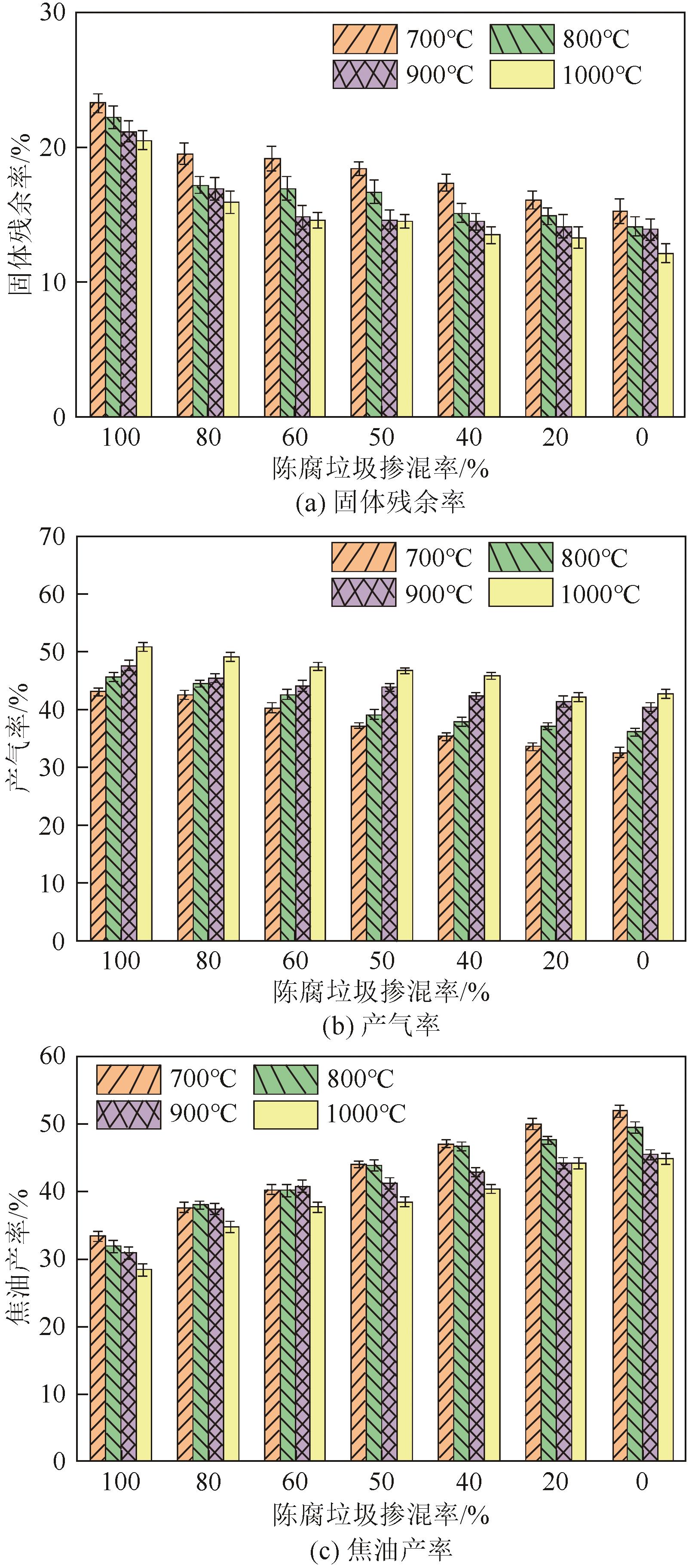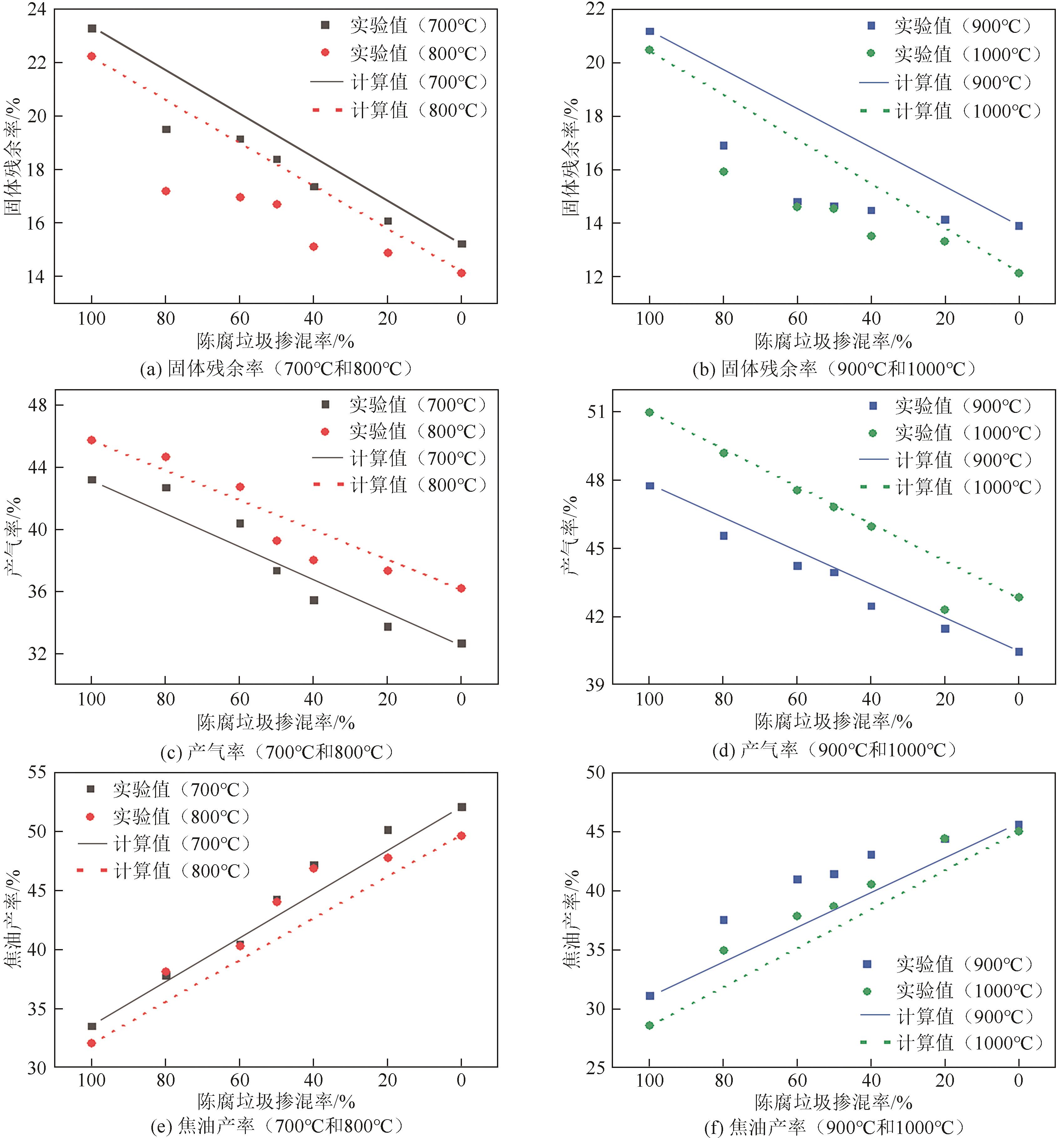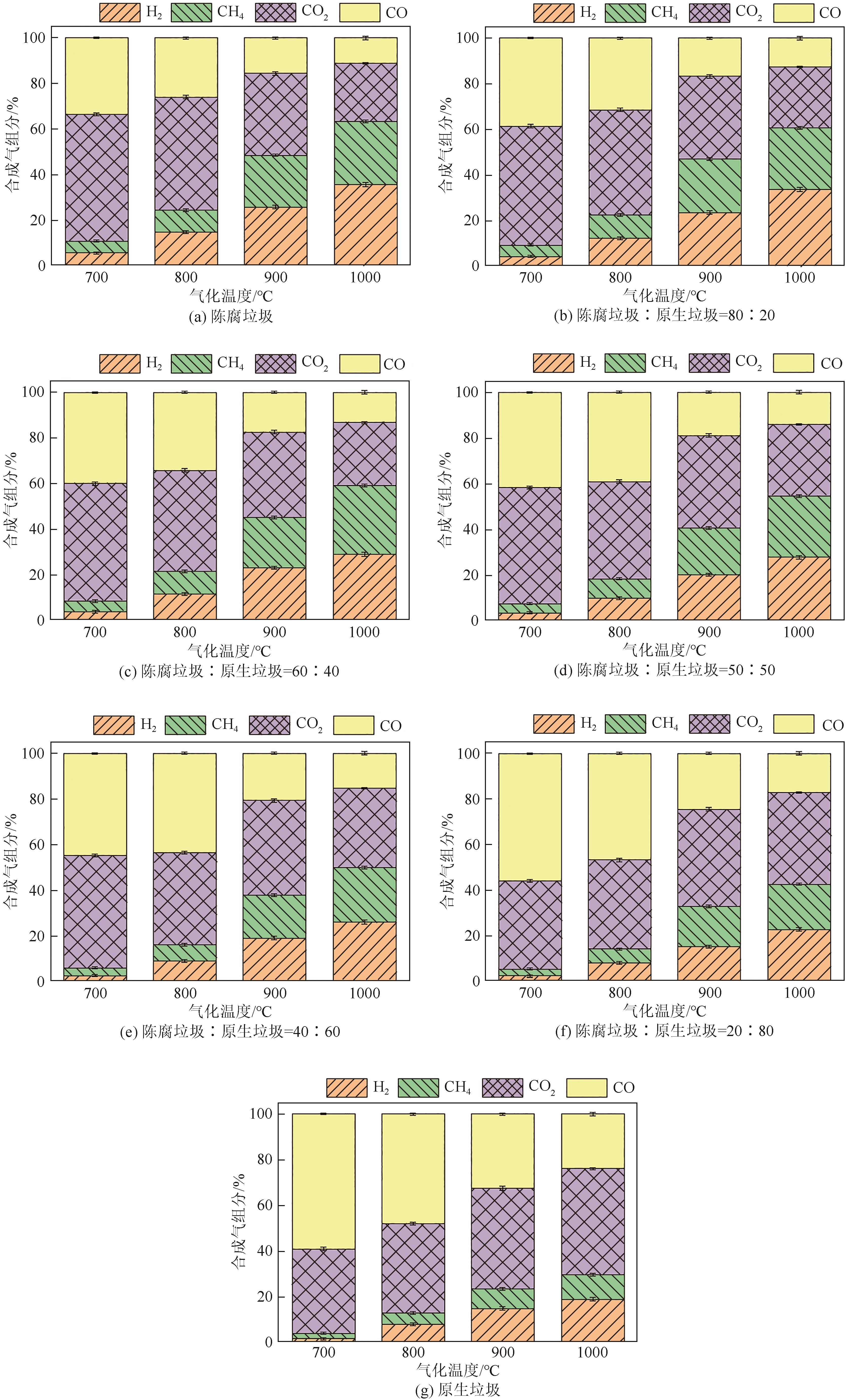Chemical Industry and Engineering Progress ›› 2025, Vol. 44 ›› Issue (1): 525-537.DOI: 10.16085/j.issn.1000-6613.2023-2218
• Resources and environmental engineering • Previous Articles Next Articles
Co-gasification characteristics of excavated waste and municipal solid waste blends
LI Hao1( ), SUN Yunan1(
), SUN Yunan1( ), LI Jian2, TAO Junyu1, CHENG Zhanjun2,3, YAN Beibei2,4, CHEN Guanyi1,2
), LI Jian2, TAO Junyu1, CHENG Zhanjun2,3, YAN Beibei2,4, CHEN Guanyi1,2
- 1.School of Mechanical Engineering, Tianjin University of Commerce, Tianjin 300134, China
2.School of Environmental Science and Engineering, Tianjin University, Tianjin 300350, China
3.Engineering Research Center for Organic Wastes Safe Disposal and Energy Utilization, Tianjin 300072, China
4.Tianjin Key Lab of Biomass Wastes Utilization/Tianjin Engineering Research Center of Bio Gas/Oil Technology, Tianjin 300072, China
-
Received:2023-12-18Revised:2024-02-27Online:2025-02-13Published:2025-01-15 -
Contact:SUN Yunan
陈腐垃圾与原生垃圾共气化特性
李灏1( ), 孙昱楠1(
), 孙昱楠1( ), 李健2, 陶俊宇1, 程占军2,3, 颜蓓蓓2,4, 陈冠益1,2
), 李健2, 陶俊宇1, 程占军2,3, 颜蓓蓓2,4, 陈冠益1,2
- 1.天津商业大学机械工程学院,天津 300134
2.天津大学环境科学与工程学院,天津 300350
3.天津市有机废物安全处置与能源利用工程研究中心,天津 300072
4.天津市生物质废弃物资源化利用重点实验室/天津市生物油技术工程研究中心,天津 300072
-
通讯作者:孙昱楠 -
作者简介:李灏(1998—),男,硕士研究生,研究方向为陈腐垃圾热解气化。E-mail: lihao1823689864@163.com。 -
基金资助:西藏自治区科技计划(XZ202301ZY0029G)
CLC Number:
Cite this article
LI Hao, SUN Yunan, LI Jian, TAO Junyu, CHENG Zhanjun, YAN Beibei, CHEN Guanyi. Co-gasification characteristics of excavated waste and municipal solid waste blends[J]. Chemical Industry and Engineering Progress, 2025, 44(1): 525-537.
李灏, 孙昱楠, 李健, 陶俊宇, 程占军, 颜蓓蓓, 陈冠益. 陈腐垃圾与原生垃圾共气化特性[J]. 化工进展, 2025, 44(1): 525-537.
share this article
Add to citation manager EndNote|Ris|BibTeX
URL: https://hgjz.cip.com.cn/EN/10.16085/j.issn.1000-6613.2023-2218
| 原料掺混比/% | 元素分析/% | 工业分析/% | 原料热值 /MJ·kg-1 | ||||||
|---|---|---|---|---|---|---|---|---|---|
| (陈腐垃圾:原生垃圾) | C | H | N | O | 水分 | 灰分 | 挥发分 | 固定碳 | |
| 100∶0 | 59.93 | 8.05 | 1.39 | 15.63 | 1.61 | 16.95 | 75.38 | 6.06 | 23.56 |
| 80∶20 | 55.97 | 7.50 | 1.43 | 17.58 | 1.71 | 15.49 | 74.23 | 8.57 | 18.09 |
| 60∶40 | 52.02 | 6.94 | 1.47 | 19.53 | 1.80 | 14.03 | 73.08 | 11.09 | 17.46 |
| 50∶50 | 50.04 | 6.67 | 1.50 | 20.51 | 1.85 | 13.29 | 72.51 | 12.35 | 16.60 |
| 40∶60 | 48.06 | 6.39 | 1.52 | 21.49 | 1.90 | 12.56 | 71.94 | 13.60 | 15.07 |
| 20∶80 | 44.11 | 5.83 | 1.56 | 23.44 | 2.01 | 11.10 | 70.78 | 16.11 | 12.55 |
| 0∶100 | 40.15 | 5.28 | 1.60 | 25.39 | 2.10 | 9.64 | 69.63 | 18.63 | 10.04 |
| 原料掺混比/% | 元素分析/% | 工业分析/% | 原料热值 /MJ·kg-1 | ||||||
|---|---|---|---|---|---|---|---|---|---|
| (陈腐垃圾:原生垃圾) | C | H | N | O | 水分 | 灰分 | 挥发分 | 固定碳 | |
| 100∶0 | 59.93 | 8.05 | 1.39 | 15.63 | 1.61 | 16.95 | 75.38 | 6.06 | 23.56 |
| 80∶20 | 55.97 | 7.50 | 1.43 | 17.58 | 1.71 | 15.49 | 74.23 | 8.57 | 18.09 |
| 60∶40 | 52.02 | 6.94 | 1.47 | 19.53 | 1.80 | 14.03 | 73.08 | 11.09 | 17.46 |
| 50∶50 | 50.04 | 6.67 | 1.50 | 20.51 | 1.85 | 13.29 | 72.51 | 12.35 | 16.60 |
| 40∶60 | 48.06 | 6.39 | 1.52 | 21.49 | 1.90 | 12.56 | 71.94 | 13.60 | 15.07 |
| 20∶80 | 44.11 | 5.83 | 1.56 | 23.44 | 2.01 | 11.10 | 70.78 | 16.11 | 12.55 |
| 0∶100 | 40.15 | 5.28 | 1.60 | 25.39 | 2.10 | 9.64 | 69.63 | 18.63 | 10.04 |
| 序号 | 陈腐垃圾掺混比/% | 温度 /℃ | H2体积分数 /% | CH4体积分数 /% | H2产率 /mL·g-1 | CH4产率 /mL·g-1 | CO产率 /mL·g-1 | 合成气热值 /MJ·m-3 | 碳转化率 /% | 气化效率 /% |
|---|---|---|---|---|---|---|---|---|---|---|
| 1 | 100 | 1000 | 34.59 | 29.73 | 188.44 | 104.22 | 62.43 | 15.49 | 33.81 | 34.36 |
| 2 | 84 | 1000 | 33.56 | 30.79 | 168.05 | 95.53 | 60.96 | 15.65 | 34.12 | 36.17 |
| 3 | 96 | 1000 | 34.42 | 30.21 | 183.39 | 102.51 | 62.55 | 15.48 | 34.10 | 34.63 |
| 4 | 60 | 1000 | 30.02 | 28.42 | 121.98 | 72.79 | 54.54 | 16.00 | 29.96 | 30.38 |
| 5 | 89 | 989 | 33.25 | 29.83 | 162.78 | 90.84 | 61.08 | 15.01 | 34.44 | 33.12 |
| 序号 | 陈腐垃圾掺混比/% | 温度 /℃ | H2体积分数 /% | CH4体积分数 /% | H2产率 /mL·g-1 | CH4产率 /mL·g-1 | CO产率 /mL·g-1 | 合成气热值 /MJ·m-3 | 碳转化率 /% | 气化效率 /% |
|---|---|---|---|---|---|---|---|---|---|---|
| 1 | 100 | 1000 | 34.59 | 29.73 | 188.44 | 104.22 | 62.43 | 15.49 | 33.81 | 34.36 |
| 2 | 84 | 1000 | 33.56 | 30.79 | 168.05 | 95.53 | 60.96 | 15.65 | 34.12 | 36.17 |
| 3 | 96 | 1000 | 34.42 | 30.21 | 183.39 | 102.51 | 62.55 | 15.48 | 34.10 | 34.63 |
| 4 | 60 | 1000 | 30.02 | 28.42 | 121.98 | 72.79 | 54.54 | 16.00 | 29.96 | 30.38 |
| 5 | 89 | 989 | 33.25 | 29.83 | 162.78 | 90.84 | 61.08 | 15.01 | 34.44 | 33.12 |
| 1 | NANDA Sonil, BERRUTI Franco. Municipal solid waste management and landfilling technologies: A review[J]. Environmental Chemistry Letters, 2021, 19(2): 1433-1456. |
| 2 | JAIN Mohit, KUMAR Ashwani, KUMAR Amit. Landfill mining: A review on material recovery and its utilization challenges[J]. Process Safety and Environmental Protection, 2023, 169: 948-958. |
| 3 | RONG Liming, ZHANG Chengliang, JIN Dongsheng, et al. Assessment of the potential utilization of municipal solid waste from a closed irregular landfill[J]. Journal of Cleaner Production, 2017, 142: 413-419. |
| 4 | QUAGHEBEUR Mieke, LAENEN Ben, GEYSEN Daneel, et al. Characterization of landfilled materials: Screening of the enhanced landfill mining potential[J]. Journal of Cleaner Production, 2013, 55: 72-83. |
| 5 | MOU Zishen, SCHEUTZ Charlotte, KJELDSEN Peter. Evaluating the biochemical methane potential (BMP) of low-organic waste at Danish landfills[J]. Waste Management, 2014, 34(11): 2251-2259. |
| 6 | DU Yufeng, JU Tongyao, MENG Yuan, et al. A review on municipal solid waste pyrolysis of different composition for gas production[J]. Fuel Processing Technology, 2021, 224: 107026. |
| 7 | BOSMANS Anouk, DE DOBBELAERE Christopher, HELSEN Lieve. Pyrolysis characteristics of excavated waste material processed into refuse derived fuel[J]. Fuel, 2014, 122: 198-205. |
| 8 | DU Yufeng, JU Tongyao, MENG Yuan, et al. Pyrolysis characteristics of excavated waste and generation mechanism of gas products[J]. Journal of Cleaner Production, 2022, 370: 133489. |
| 9 | AGON N, HRABOVSKÝ M, CHUMAK O, et al. Plasma gasification of refuse derived fuel in a single-stage system using different gasifying agents[J]. Waste Management, 2016, 47: 246-255. |
| 10 | MATERAZZI M, LETTIERI P, TAYLOR R, et al. Performance analysis of RDF gasification in a two stage fluidized bed-plasma process[J]. Waste Management, 2016, 47: 256-266. |
| 11 | LAOHALIDANOND Krongkaew, KERDSUWAN Somrat, BURRA Kiran Raj Goud, et al. Syngas generation from landfills derived torrefied refuse fuel using a downdraft gasifier[J]. Journal of Energy Resources Technology, 2021, 143(5): 052102. |
| 12 | ZAINI Ilman Nuran, GARCÍA LÓPEZ Cristina, PRETZ Thomas, et al. Characterization of pyrolysis products of high-ash excavated-waste and its char gasification reactivity and kinetics under a steam atmosphere[J]. Waste Management, 2019, 97: 149-163. |
| 13 | LI Debo, FENG Yongxin, CHEN Zhihao, et al. Co-combustion of aged refuse and municipal solid waste under increased N2/O2 atmospheres: Kinetics analysis, thermodynamic characteristics[J]. Energy Sources, Part A: Recovery, Utilization, and Environmental Effects, 2021:1-13. |
| 14 | LI Debo, FENG Yongxin, CHEN Zhihao, et al. Effects of atmosphere and blending ratios on emission characteristics of pollutants from co-combustion of municipal solid waste and aged refuse[J]. Asia-Pacific Journal of Chemical Engineering, 2022, 17(2): 2746. |
| 15 | ZAINI Ilman Nuran, Yamid GOMEZ-RUEDA, GARCÍA LÓPEZ Cristina, et al. Production of H2-rich syngas from excavated landfill waste through steam co-gasification with biochar[J]. Energy, 2020, 207: 118208. |
| 16 | MOON Jihong, Tae-Young MUN, YANG Won, et al. Effects of hydrothermal treatment of sewage sludge on pyrolysis and steam gasification[J]. Energy Conversion and Management, 2015, 103: 401-407. |
| 17 | Fábio Codignole LUZ, ROCHA Mateus Henrique, LORA Electo Eduardo Silva, et al. Techno-economic analysis of municipal solid waste gasification for electricity generation in Brazil[J]. Energy Conversion and Management, 2015, 103: 321-337. |
| 18 | HU Mian, GAO Lan, CHEN Zhihua, et al. Syngas production by catalytic in situ steam co-gasification of wet sewage sludge and pine sawdust[J]. Energy Conversion and Management, 2016, 111: 409-416. |
| 19 | ZHU Yanli, ZHANG Youxian, LUO Dongxia, et al. A review of municipal solid waste in China: Characteristics, compositions, influential factors and treatment technologies[J]. Environment Development and Sustainability, 2021, 23(5): 6603-6622. |
| 20 | DARMEY James, AHIEKPOR Julius Cudjoe, NARRA Sstyanarayana, et al. Municipal solid waste generation trend and bioenergy recovery potential: A review[J]. Energies, 2023, 16(23): 7753. |
| 21 | KHAN Afzal Husain, LÓPEZ-MALDONADO Eduardo Alberto, KHAN Nadeem A, et al. Current solid waste management strategies and energy recovery in developing countries—State of art review[J]. Chemosphere, 2022, 291: 133088. |
| 22 | DING Yin, ZHAO Jun, LIU Jiawei, et al. A review of China’s municipal solid waste (MSW) and comparison with international regions: Management and technologies in treatment and resource utilization[J]. Journal of Cleaner Production, 2021, 293: 126144. |
| 23 | 孙子维, 张雨轩, 唐玉婷, 等. 城市生活垃圾与陈腐垃圾掺烧的燃烧特性与反应动力学分析[J]. 环境卫生工程, 2023, 31(6): 1-10. |
| SUN Ziwei, ZHANG Yuxuan, TANG Yuting, et al. Combustion characteristics and kinetic analysis of the co-combustion of MSW and excavated waste[J]. Environmental Sanitation Engineering, 2023, 31(6): 1-10. | |
| 24 | WEN Yuming, SHI Ziyi, WANG Shule, et al. Pyrolysis of raw and anaerobically digested organic fractions of municipal solid waste: Kinetics, thermodynamics, and product characterization[J]. Chemical Engineering Journal, 2021, 415: 129064. |
| 25 | SALEH Arif Rahman, SUDARMANTA Bambang, FANSURI Hamzah, et al. Improved municipal solid waste gasification efficiency using a modified downdraft gasifier with variations of air input and preheated air temperature[J]. Energy & Fuels, 2019, 33(11): 11049-11056. |
| 26 | CAI Jianjun, ZENG Ronghua, ZHENG Wenheng, et al. Synergistic effects of co-gasification of municipal solid waste and biomass in fixed-bed gasifier[J]. Process Safety and Environmental Protection, 2021, 148: 1-12. |
| 27 | 汪德成, 金保昇, 金朝阳, 等. 松木屑与废橡胶化学链共气化特性试验[J]. 化工进展, 2020, 39(3): 956-965. |
| WANG Decheng, JIN Baosheng, JIN Zhaoyang, et al. High hydrogen syngas production from chemical looping co-gasification of sawdust and waste tires[J]. Chemical Industry and Engineering Progress, 2020, 39(3): 956-965. | |
| 28 | HU Qiang, DAI Yanjun, WANG Chi-Hwa. Steam co-gasification of horticultural waste and sewage sludge: Product distribution, synergistic analysis and optimization[J]. Bioresource Technology, 2020, 301: 122780. |
| 29 | SHAHBAZ Muhammad, YUSUP Suzana, INAYAT Abrar, et al. Cleaner production of hydrogen and syngas from catalytic steam palm kernel shell gasification using CaO sorbent and coal bottom ash as a catalyst[J]. Energy & Fuels, 2017, 31(12): 13824-13833. |
| 30 | ABDALAZEEZ Atif, LI Tianle, WANG Wenju, et al. A brief review of CO2 utilization for alkali carbonate gasification and biomass/coal co-gasification: Reactivity, products and process[J]. Journal of CO2 Utilization, 2021, 43: 101370. |
| 31 | CHAN Weiping, AL MUNAWARAH BINTE YUSOFF Sofea, VEKSHA Andrei, et al. Analytical assessment of tar generated during gasification of municipal solid waste: Distribution of GC-MS detectable tar compounds, undetectable tar residues and inorganic impurities[J]. Fuel, 2020, 268: 117348. |
| 32 | LIU Zhenling. Gasification of municipal solid wastes: A review on the tar yields[J]. Energy Sources A: Recovery, Utilization, and Environmental Effects, 2019, 41(11): 1296-1304. |
| 33 | SANCHEZ-SILVA L, LÓPEZ-GONZÁLEZ D, GARCIA-MINGUILLAN A M, et al. Pyrolysis, combustion and gasification characteristics of Nannochloropsis gaditana microalgae[J]. Bioresource Technology, 2013, 130: 321-331. |
| 34 | ZHANG Yike, MA Zengyi, YAN Jianhua. Effect of water, fat, and protein in raw pork from swine carcasses on the pyrolytic gaseous and liquid product distribution[J]. Fuel Processing Technology, 2018, 171: 45-53. |
| 35 | BRACHI Paola, CHIRONE Riccardo, MICCIO Francesco, et al. Fluidized bed co-gasification of biomass and polymeric wastes for a flexible end-use of the syngas: Focus on bio-methanol[J]. Fuel, 2014, 128: 88-98. |
| 36 | MOGHADAM Reza Alipour, YUSUP Suzana, UEMURA Yoshimitsu, et al. Syngas production from palm kernel shell and polyethylene waste blend in fluidized bed catalytic steam co-gasification process[J]. Energy, 2014, 75: 40-44. |
| 37 | PARRILLO Francesco, ARDOLINO Filomena, BOCCIA Carmine, et al. Co-gasification of plastics waste and biomass in a pilot scale fluidized bed reactor[J]. Energy, 2023, 273: 127220. |
| 38 | HALBA Ankush, THENGANE Sonal K, ARORA Pratham. A critical outlook on lignocellulosic biomass and plastics co-gasification: A mini-review[J]. Energy & Fuels, 2023, 37(1): 19-35. |
| 39 | HUANG Jingchun, QIAO Yu, WANG Zhenqi, et al. Valorization of food waste via torrefaction: Effect of food waste type on the characteristics of torrefaction products[J]. Energy & Fuels, 2020, 34(5): 6041-6051. |
| 40 | SINGH Dharminder, RAIZADA Aayush, YADAV Sanjeev. Syngas production from fast pyrolysis and steam gasification of mixed food waste[J]. Waste Management & Research, 2022, 40(11): 1669-1675. |
| 41 | XIE Di, ZHONG Yi, HUANG Jingchun, et al. Steam gasification of the raw and torrefied mixed typical food wastes: Effect of interactions on syngas production[J]. Fuel, 2022, 323: 124354. |
| 42 | MISHRA Rahul, Hwai Chyuan ONG, LIN Chiwen. Progress on co-processing of biomass and plastic waste for hydrogen production[J]. Energy Conversion and Management, 2023, 284: 116983. |
| 43 | LIU Qingyu, HU Changsong, PENG Bo, et al. High H2/CO ratio syngas production from chemical looping co-gasification of biomass and polyethylene with CaO/Fe2O3 oxygen carrier[J]. Energy Conversion and Management, 2019, 199: 111951. |
| 44 | MISHRA Rahul, SINGH Ekta, KUMAR Aman, et al. Co-gasification of solid waste and its impact on final product yields[J]. Journal of Cleaner Production, 2022, 374: 133989. |
| 45 | BRITO João, PINTO F, FERREIRA Alexandre, et al. Steam reforming of biomass gasification gas for hydrogen production: From thermodynamic analysis to experimental validation[J]. Fuel Processing Technology, 2023, 250: 107859. |
| 46 | HUSSEIN M S, BURRA K G, AMANO R S, et al. Temperature and gasifying media effects on chicken manure pyrolysis and gasification[J]. Fuel, 2017, 202: 36-45. |
| [1] | LIANG Yongqi, TANG Jian, XIA Heng, CHEN Jiakun, QIAO Junfei. Modeling and analysis of particulate matter concentration in incinerator under benchmark conditions based on coupled numerical simulation [J]. Chemical Industry and Engineering Progress, 2024, 43(S1): 106-120. |
| [2] | CHEN Juhui, WANG Zhenming, LI Dan, WANG Bosen, ZHURAVKOV Michael, SIARHEI Lapatsin, YU Guangbin. Simulation of gasification characteristics from municipal solid waste under different moisture content [J]. Chemical Industry and Engineering Progress, 2024, 43(9): 4900-4908. |
| [3] | KONG Xiangrui, DONG Yuecen, ZHANG Mengyu, WANG Biao, YIN Shui′e, CHEN Bing, LU Jiawei, ZHANG Yuan, FENG Lele, WANG Hongtao, XU Haiyun. Treatment technologies of fly ash from municipal solid waste incineration [J]. Chemical Industry and Engineering Progress, 2024, 43(7): 4102-4117. |
| [4] | TIAN Tong, HUANG Yaji, XIAO Yixuan, CHENG Haoqiang, PAN Hu, ZHOU Qi, LI Zenghui. Characterization of heavy metals migration from leachate-leaching municipal solid waste incineration bottom ash [J]. Chemical Industry and Engineering Progress, 2024, 43(11): 6514-6523. |
| [5] | ZHANG Shan, ZHONG Zhaoping, YANG Yuxuan, DU Haoran, LI Qian. Enrichment of heavy metals in pyrolysis of municipal solid waste by phosphate modified kaolin [J]. Chemical Industry and Engineering Progress, 2023, 42(7): 3893-3903. |
| [6] | LI Weihua, WU Yinkai, SUN Yingjie, YIN Junquan, XIN Mingxue, ZHAO Youjie. Progress on evaluation methods for toxic leaching of heavy metals from MSW incineration fly ash [J]. Chemical Industry and Engineering Progress, 2023, 42(5): 2666-2677. |
| [7] | CHEN Jiakun, TANG Jian, XIA Heng, QIAO Junfei. Numerical simulation of dioxin emission concentration in grate furnace incineration processes for municipal solid waste [J]. Chemical Industry and Engineering Progress, 2023, 42(2): 1061-1072. |
| [8] | LI Jingjing, ZHAO Yao, XU Fengchi, LI Kangjian. Heavy metal leaching characteristics of porous asphalt mixture containing MSWI-BAA under different stormwater runoff flow rates [J]. Chemical Industry and Engineering Progress, 2023, 42(10): 5520-5530. |
| [9] | LIU Yang, HUANG Yaji, DONG Xinxin, DING Xueyu, YANG Xiaoyu, WANG Xinyu, ZHANG Zhenrong, CAO Gehan, LI Zhiyuan, TIAN Xinqi. In-situ sulfur fixation performance of Ca-Fe composite metal oxides during gasification of combustible municipal solid waste [J]. Chemical Industry and Engineering Progress, 2022, 41(10): 5677-5684. |
| [10] | JIANG Xuguang, CHEN Qian, ZHAO Xiaoli, KONG Litan. A review on hydrothermal treatment for stabilization of heavy metals in fly ash from municipal solid waste incineration [J]. Chemical Industry and Engineering Progress, 2021, 40(8): 4473-4485. |
| [11] | YAN Xin, LI Xiaodong, ZHU Fengsen, KONG Xiangzhi, YAN Jianhua. Decomposition of naphthalene as tar model compound from the gasification of municipal solid waste by rotating gliding arc plasma [J]. Chemical Industry and Engineering Progress, 2018, 37(03): 1174-1180. |
| [12] | SUN Li, WU Xin, LIU Daojie, LI Junhui, LI Shi, DU Yiwei. Stabilization of heavy metals in municipal solid waste incineration fly ash using thermal treatment with silica-based material [J]. Chemical Industry and Engineering Progress, 2017, 36(09): 3514-3522. |
| [13] | YANG Zhifang, DU Feng, YU Qingjiang, GUO Luyue, ZHANG Pingping. Internals optimization of 78.5L airlift loop reactor [J]. Chemical Industry and Engineering Progree, 2015, 34(3): 659-663. |
| [14] | XIONG Zuhong,FAN Genyu,LU Min,GUO Huafang,CHEN Yong. Treatment technologies of municipal solid waste incinerator fly ash: A review [J]. Chemical Industry and Engineering Progree, 2013, 32(07): 1678-1684. |
| Viewed | ||||||
|
Full text |
|
|||||
|
Abstract |
|
|||||





